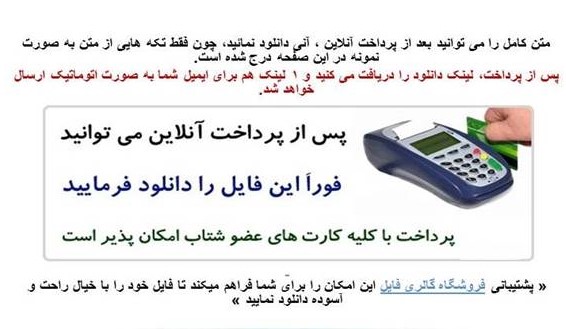لینک دانلود و خرید پایین توضیحات
فرمت فایل word و قابل ویرایش و پرینت
تعداد صفحات: 14
Information technology
What is electronic and information technology?
"Electronic and information technology" is a term used in the 1998 amendments to Section 508 of the Rehabilitation Act. The term is used to define the scope of products covered under Section 508. Section 508 requires that electronic and information technology that is developed, procured, maintained, or used by the federal government be accessible.
Electronic and information technology includes computer hardware and software, operating systems, web-based information and applications, telephones and other telecommunications products, video equipment and multimedia products, information kiosks, and office products such as photocopiers and fax machines.
Informally, all of these devices are commonly referred to simply as "information technology," or "IT." However, from a legal standpoint, there was a need to expand upon an existing federal definition of information technology, while maintaining consistency with that early definition.
The federal agency charged with establishing this definition was the Architectural and Transportation Barriers Compliance Board (Access Board). Here is the formal definition of both "electronic and information technology" and "information technology" published in the Access Board's Electronic and Information Technology Accessibility Standards:
Electronic and information technology. Includes information technology and any equipment or interconnected system or subsystem of equipment, that is used in the creation, conversion, or duplication of data or information. The term electronic and information technology includes, but is not limited to, telecommunications products (such as telephones), information kiosks and transaction machines, World Wide Web sites, multimedia, and office equipment such as copiers and fax machines. The term does not include any equipment that contains embedded information technology that is used as an integral part of the product, but the principal function of which is not the acquisition, storage, manipulation, management, movement, control, display, switching, interchange, transmission, or reception of data or information. For example, HVAC (heating, ventilation, and air conditioning) equipment such as thermostats or temperature control devices, and medical equipment where information technology is integral to its operation, are not information technology.
Information technology. Any equipment or interconnected system or subsystem of equipment, that is used in the automatic acquisition, storage, manipulation, management, movement, control, display, switching, interchange, transmission, or reception of data or information. The term 'information technology' includes computers, ancillary equipment, software, firmware and similar procedures, services (including support services), and related resources.
Information technology (IT), as defined by the Information Technology Association of America (ITAA), is "the study, design, development, implementation, support or management of computer-based information systems, particularly software applications and computer hardware." In short, IT deals with the use of electronic computers and computer software to convert, store, protect, process, transmit and retrieve information, securely.
Recently it has become popular to broaden the term to explicitly include the field of electronic communication so that people tend to use the abbreviation ICT (Information and Communications Technology).
Information technology today
Today, the term information technology has ballooned to encompass many aspects of computing and technology, and the term is more recognizable than ever before. The information technology umbrella can be quite large, covering many fields. IT professionals perform a variety of duties that range from installing applications to designing complex computer networks and information databases. A few of the duties that IT professionals perform may include:
Data management
Computer networking
Database systems design
Software design
Management information systems
Systems management
Data management
Data management comprises all the disciplines related to managing data as a valuable resource. The official definition provided by DAMA is that "Data Resource Management is the development and execution of architectures, policies, practices and procedures that properly manage the full data lifecycle needs of an enterprise." This definition is fairly broad and encompasses a number of professions which may not have direct technical contact with lower-level aspects of data management, such as relational database management.
Topics in Data Management include:
Data analysis
Database management system
Data modeling
Database administration
Data warehousing
Data movement
Data mining
Data quality assurance
Data security
Meta-data management (data repositories, and their management)
Data architecture
Management information system
Management Information Systems (MIS) is a general name for the academic discipline covering the application of people, technologies, and procedures — collectively called information systems — to solve business problems. MIS are distinct from regular information systems in that they are used to analyze other information systems applied in operational activities in the organization.[1] Academically, the term is commonly used to refer to the group of information management methods tied to the automation or support of human decision making, e.g. Decision Support Systems, Expert systems, and Executive information systems.[1]
Background
In their infancy, business computers were used for the practical business of computing the payroll and keeping track of accounts payable and receivable. As applications were developed that provided managers with information about sales, inventories, and other data that would help in managing the enterprise, the term "MIS" arose to describe these kinds of applications. Today, the term is used broadly in a number of contexts and includes (but is not limited to): decision support systems, resource and people management applications, project management, and database retrieval applications.
Definition
There are often confusion between terms MIS and information system. Information systems include systems that are not intended for decision making. MIS is sometimes referred to, in a restrictive sense, as information technology management. That area of study should not be confused with computer science. IT service management is a practitioner-focused discipline. MIS has also some differences with Enterprise Resource Planning (ERP) as ERP incorporates elements that are not necessarily focused on decision support.

تحقیق درمورد فناوری اطلاعات 13 ص